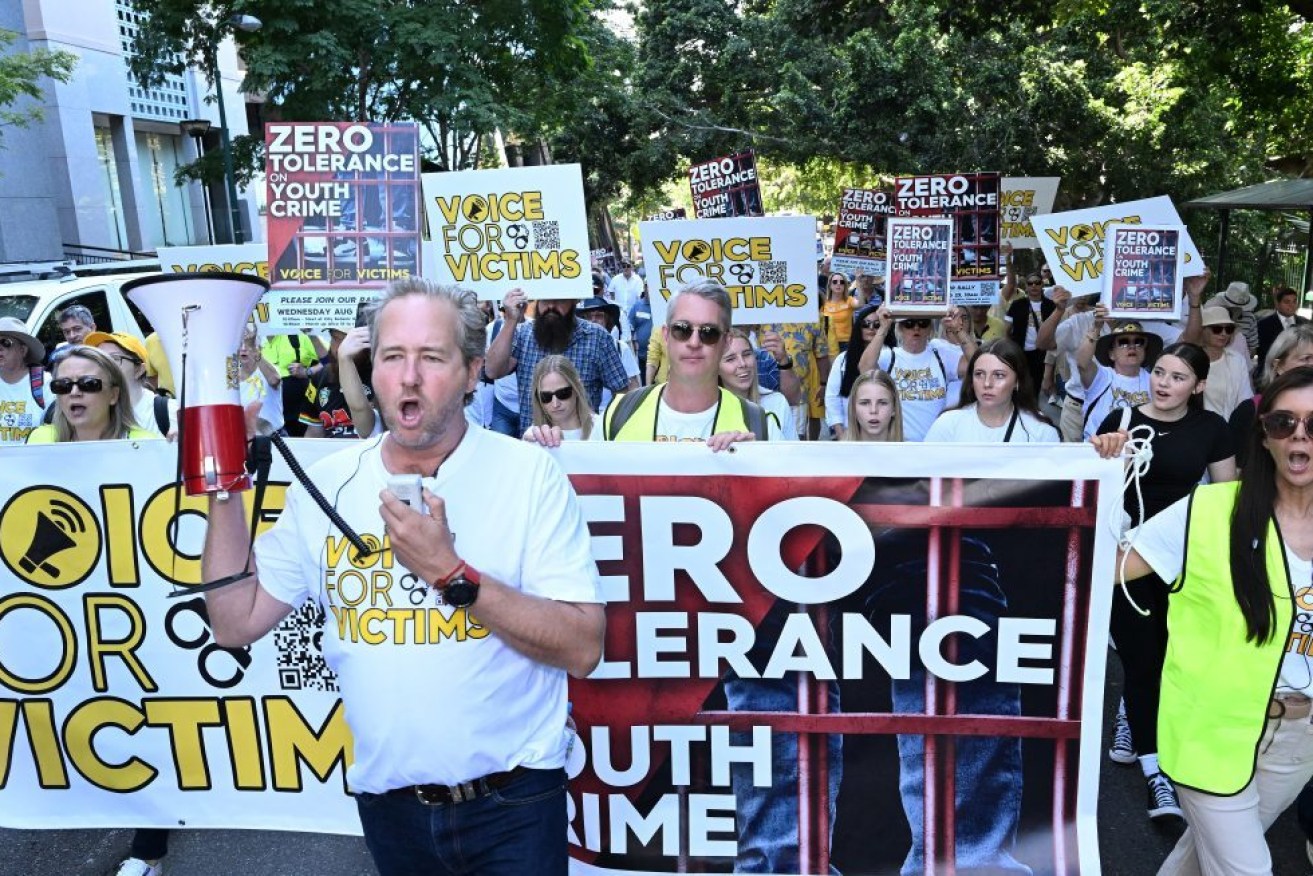True crime: Why numbers show youth crime isn’t the crisis, real problem is adults
There are some people and organisations who thrive on generating fear.


Ben Cannon leads protestors during a Voice for Victims community group rally in Brisbane, Wednesday, August 23, 2023. Victims of crime and their supporters held a rally to protest Queensland’s youth crime rates and the justice system. (AAP Image/Darren England) NO ARCHIVING
It’s a terrible part of the political and media landscape. Not all of it or even most of it, but some.
That fear can and does distort the real impact of issues like crime and makes sensible debate difficult.
And that’s where we are now.
There is no disguising the fact that areas of crime are a major concern and if the community believes it is out of control, then it is, in both political and personal terms.
And those who have been victims feel real pain and anguish that should not be diminished.
But there is no evidence to support the claims of a crime wave. In trend terms, quite the opposite.
The unpleasant flow-on from the belief that we do have a crime wave is that we are in danger of reacting badly to scare campaigns and fear.
The State Government’s suspension of the Human Rights Act to lock up children in watchhouses is an obvious example of that.
So what does the data show? Is crime as bad as some have been making out?
In some areas yes, particularly domestic violence which appears to be a much bigger social problem than many people would care to accept. The numbers are staggering. If you want to see a crime wave, this is it and it’s not teenagers who are responsible.
In 2001, there were 6500 breaches of a domestic violence orders. In 2023, there were 40,000 as women became more willing to report cases and police more willing to prosecute.
That’s a 515 per cent increase and that relates to just to the breaches of an order.
The number of assaults has increased from 19,000 in 2001 to 37,304 in 2023. That’s almost double and in 2022 it was even worse with 51,820 assaults.
QUT criminologist Professor John Scott said that was a massive under-reporting of domestic violence and the 40,000 breaches was probably the tip of the iceberg.
But he also points out that when he was studying criminology, domestic violence wasn’t even a subject, a topic or a chapter in a text book, so the response to the issue is changing.
Youth crime, which we have heard so much about, probably isn’t as bad as you think.
Scott is of the view that it is an issue, but the police were probably correct in saying it was really down to the same group of known offenders re-offending.
On the evidence, he said there didn’t appear to be a youth crime wave.
The issue then would clearly be how to deal with the repeat offenders because prison seems not to be a deterrent for many.
According to data from the 2021-2022 the rate of unique child offenders had continued its steady decline to 1926.4 per 100,000 persons aged 10–17 years, the lowest level recorded over the 10-year time series.
And the report found that there were more than 20 per cent fewer unique youth offenders in 2021–22, compared to 2012–13.
It seems remarkable when considering the daily output of news in recent times, but to be clear that is the number of people involved in crime, not the number of crimes.
According to the crime statistics from the Queensland Police, unlawful entry is down significantly over the past 20 years and in more recent years as well. There were 73,434 unlawful entries in 2001 and in 2023 there were 34,267.
Unlawful use of a motor vehicle fell between 2022 and 2023 by a substantial amount but the trend is clearly up.
Murder rates have plummeted in the past 20 years. The reduction is remarkable.
Fraud has fallen significantly in the past 20 years. Drug offences have increased but not substantially and in recent years there has been a marked reduction. There was a peak in 2020 of 88,622. In 2023, that halved to 40,741.
Believe it or not, even traffic offences were down over the past 20 years, not substantially, but given the increase in population it is a fairly impressive result.
“Areas of crime will go up and down but what you define as a wave is something different,’’ Scott said.
“I am not seeing a crime wave.
“In terms of youth crime, there appears to be a hard-core group of repeat offenders that are well known to police and causing quite a bit of trouble.”
He said growth in crime was associated with population growth and population movement and even geography plays a part.
“We are also a regionalised state and we have fairly large inland centres and services are not always up to scratch in those places,’’ he said.
Also, some modelling shows that violent crime increases as you move away from population centres to small communities.
“When it comes to violent crime you are dealing with people who have to interact with each other on a daily basis. If some bloke goes to the pub, has too much and biffs someone, that’s unlikely to be reported because everyone has to live with each other,” Scott said.
“If you look at the indigenous population they tend to be younger than the rest of the population particularly in regional areas. And we know one thing about crime is that you are most likely to offend between the ages of 16 to 24.
“If you have more young blokes in a particular place, you are probably going to have more crime.’’












